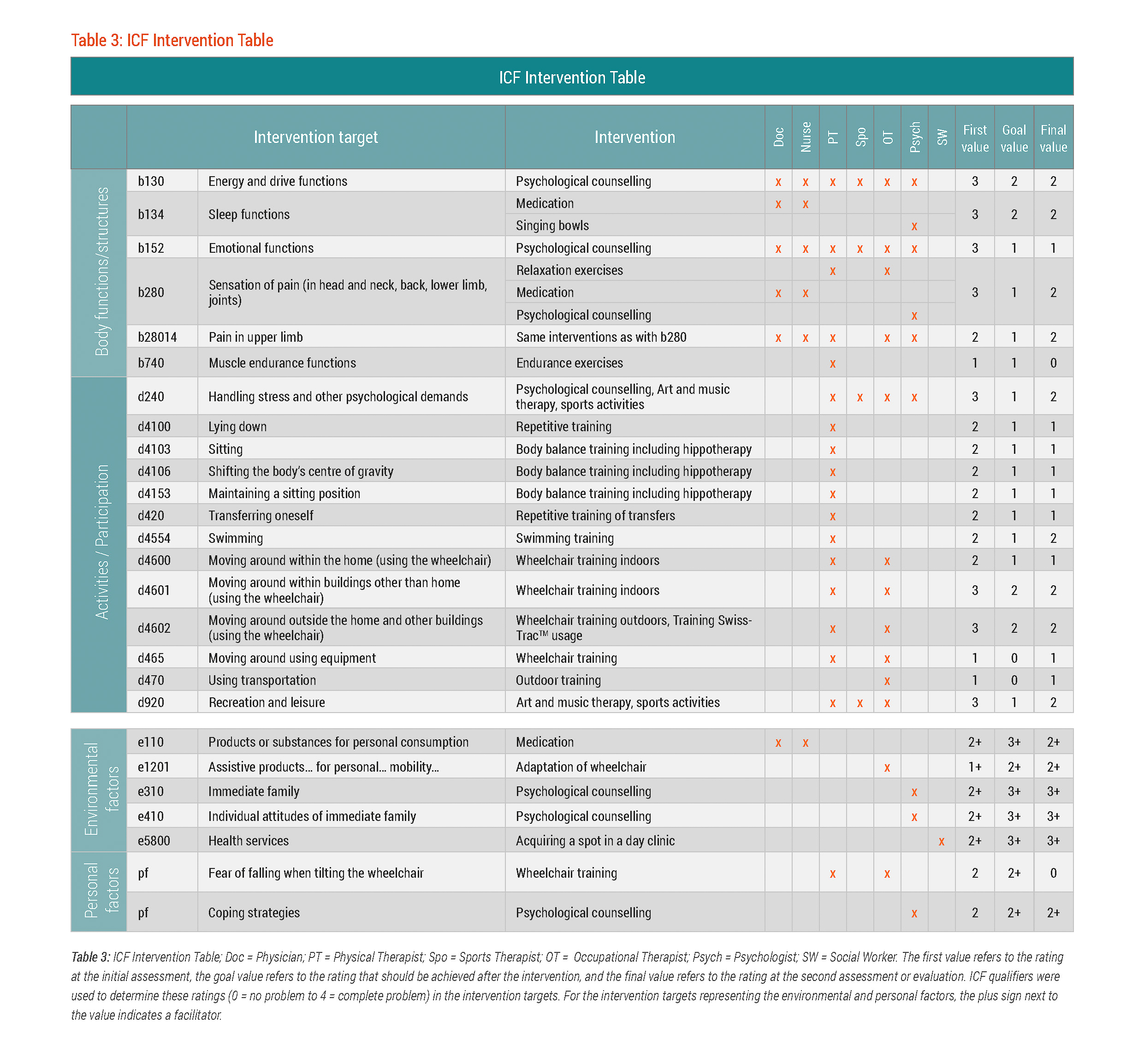Assignment and Intervention

A Multi-modal Approach
Since previous rehabilitation efforts to manage Ida's chronic pain that focused on pharmacological interventions proved unsuccessful, a more comprehensive approach was taken. In addition to pharmacological interventions, for which the physician was responsible, Ida's rehabilitation and pain management programme also included non-pharmacological interventions. While the physical, sports, and occupational therapists were responsible for the non-pharmacological interventions involving sports, relaxation exercises, and art and music therapy, the psychologist provided psychological counselling that also included conducting therapy sessions using singing bowels.
""In addition to pharmacological interventions...Ida's rehabilitation and pain management programme also included non-pharmacological interventions.""
These non-pharmacological interventions intended to address the intervention targets associated with the service-program goal ‘pain management’ and cycle goal 1 ‘handling stress and other psychological demands’. Based on the comprehensive assessment at the beginning of the Rehab-Cycle® , it was clear that Ida's pain experience was closely linked with her difficulties in coping with her situation and in handling stress. Thus, the psychologist worked extensively with Ida to develop more adaptive coping and stress management strategies. Furthermore, since Ida's immediate family was considered an important facilitator for the attainment of her pain and stress management goals and a contributor to Ida's quality of life, psychological counselling was also provided to Ida’s husband and son to enhance their supportive role.
An Interdisciplinary Approach
The members of the rehabilitation team worked interdisciplinary. For example, the physician and the psychologist worked collaboratively to treat the minor clinical depression that was diagnosed during the assessment phase. The physician prescribed an antidepressant, and the psychologist provided psychological counselling. Moreover, all of the members of Ida's rehabilitation team contributed to monitoring Ida's emotional functioning.
The interdisciplinary approach was applied not only in the interventions targeting the goals of pain management and handling stress and other psychological demands, it also extended to the interventions targeting Ida's cycle goal of improving mobility and the long-term goal of increasing Ida's participation in social life.
A Comprehensive Approach – Going Beyond Pain Itself
In Ida's case, the comprehensive approach to pain management was multi-modal and interdisciplinary. It also encompassed interventions that addressed Ida's problems in other aspects of functioning, such as mobility, that impacted on her pain experience.
The intervention targets corresponding to Ida's cycle goal 2 ‘improvement in mobility’ were addressed primarily by the physical therapist and occupational therapist. For example, the physical therapist conducted body balance training (including hippotherapy) to improve Ida's problems in getting in and out of a seated position, in shifting her body's centre of gravity, and in maintaining a sitting position. Together with the physical therapist, the occupational therapist shared the responsibility for strengthening Ida's abilities to manoeuvre her wheelchair by providing wheelchair training indoors and outdoors. Furthermore, the occupational therapist was responsible for ensuring that Ida's wheelchair was suitable for her needs.
With regard to interventions to address Ida's long-term goal of increased participation in social life, non-pharmacological interventions comprising of sports activities, relaxation exercises, art and music therapy, and psychological counselling were provided.
""This extended stay gave Ida the opportunity to evaluate whether doing arts and crafts, music therapy, and hippotherapy were suitable tools for effectively managing her pain long-term.""
The interventions and the corresponding intervention targets, as well as the rehabilitation team members who were assigned the responsibility for implementing the interventions, were documented on the ICF Intervention Table. See table 3.

Table 3: ICF Intervention Table; Doc = Physician; PT = Physical Therapist; Spo = Sports Therapist; OT = Occupational Therapist; Psych = Psychologist; SW = Social Worker. The first value refers to the rating at the initial assessment, the goal value refers to the rating that should be achieved after the intervention, and the final value refers to the rating at the second assessment or evaluation. ICF qualifiers were used to determine these ratings (0 = no problem to 4 = complete problem) in the intervention targets. For the intervention targets representing the environmental and personal factors, the plus sign next to the value indicates a facilitator.
Ida's rehabilitation and pain management programme had initially been planned to last four weeks. However, due to difficulties in finding the optimal choice and dosage of medication at the beginning of the Rehab-Cycle® , the rehabilitation programme was extended, ultimately lasting eight weeks. This extended stay gave Ida the opportunity to evaluate whether doing arts and crafts, music therapy, and hippotherapy were suitable tools for effectively managing her pain long-term.
At the end of the 8-week Rehab-Cycle® , an evaluation took place to determine Ida's progress and goal achievement.